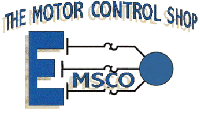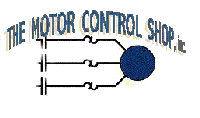

|
|
| HOME PRODUCTS PICTURES CUT SHEETS DIRECT TO YOUR CUSTOMER ON LINE ORDERING FAQ |
F.A.Q. |
||||||||||
|
EMSCO, The Motor Control Shop The Motor Control Shop, inc. FREQUENTLY ASKED QUESTIONSIf your question is not covered here... call or e-mail us for the answer!!! Click here to take you to the STARTER SIZING CHART.
Click here to view the Control Power Transformer fusing chart (Dual Primary/Single Secondary)
Click here to view/search all the EATON Cutler Hammer Catalogs
A starter is made of 2 main components; a contactor and an overload. Starting a motor generates a large in-rush of electricity and closing of the gap of the power circuit can generate a violent arc of electricity. The contactor portion of the starter closes the contacts on all phases of the current very quickly and positively, minimizing the damaging/dangerous arc. The contactor also has protective shielding to help contain this arc. The same condition can occur when the motor is turned off. Starters have contacts that are made of very strong, durable materials to provide many years of safe starting and stopping of motors. Starters are sized to the motor/voltage. (see the starter sizing chart and heater overload charts (link at top of this page) Starters also have an overload protective device that can monitor the load or amperage draw that he motor is consuming. This device is sized or set to a pre-determined maximum load the motor can safely handle. When a condition occurs that the motor exceedes the set load, the overload device opens the motor starter control circuit and the motor is turned off. Overloads come in a variety of types including a small heating type elements or solid state electronic devices. The starter is a protection device for the motor. These overloads can also monitor for phase loss and single phase conditions. Starters can be turned on by much lower (safe) control voltages. For example a starter controlling a 480V 3 phase motor can be turned on by a 24v thermostat. This provides a safe voltage for the remote devices such as switches, pilot lights, thermostats etc....By using low voltage control circuits, many small devices can be added to a motor starter to enable it to control or be controlled by simple to complex computer based systems. A good example would be a building energy management system can easily control many starters. EMSCO intigrates many low voltage devices into it's starters and can design and build starters to manage many aspects of complex motor operation, such as complex cooling tower applications.
What information do you need to give us to Order a STARTER ? 1. Horsepower of the motor
Check the name plate that is attached to the side of the motor. 2. Primary voltage (motor voltage) Voltage that the MOTOR is powered by. 3. Full load amperage draw of the motor. Need this to order the proper heater (overload protection) for the starter.
** Multi-speed motors will have
multiple amperage draw demands **
4. Control circuit voltage What is going to turn the starter on or off? Is this device remote? Is this device capable of high (line voltage of 208 or 460)? These answers will determine whether a CPT or Control Power Transformer is needed to reduce the control voltage. With disconnect -> Combo Without disconnect -> Non-Com 6. Fused power circuit or non-Fused To be more specific, does the starter need to be fused or non-fused? Is the branch circuit feeding the starter already on a properly sized fuse or breaker? If not, the starter must be fused.
7. Type of enclosure - Where is the starter being installed. (More detail below)
Examples
of controls – with custom label plates.
Indicator lights – OPTIONAL - what type of pilot lights (or colors) do you want to turn on to indicate what devices are on or off. Indicator lights are labeled with custom label plates identifying the function of the pilot light.
Click here for a graphic description. A starter in an enclosure that has a disconnect switch incorporated in the front of the enclosure. What is a NON-COM or NON-COMBO starter? Click here for a graphic description. A starter in an enclosure that has NO disconnect switch or fusing. Why would I need an OVERSIZED (E3) enclosure? Typically an oversized enclosure is needed when multiple devices are added to an enclosure. Various electrical codes require minimum wire spacing or wire bending spacing and when multiple devices are installed in an enclosure, a larger enclosure is necessary to meet code.
A couple more important HOW TO's. How to know when you need to replace starter contacts. How to wire an A200 series starter (old Westinghouse starters/contactors/lighting contactors)
ENCLOSURE TYPE DETAIL Enclosure Types NEMA Type 1 (Conforms to IP40) for Indoor Use NEMA Type 3R (Conforms to IP52) for Outdoor Use NEMA Type 4 (Conforms to IP65) for Indoor or Outdoor Use NEMA Type 4X (Conforms to IP65) for Indoor or Outdoor Use NEMA Type 7 for Hazardous Gas Locations NEMA Type 9 for Hazardous Dust Locations NEMA Type 12 (Conforms to IP62) for Indoor Use NEMA Type 12 Safety Interlock
LIGHTING CONTACTORS The new lighting contactors can be a little difficult to figure out, so here are 2 quick photos to show how to wire the mechanically held lighting contactors. 2 wire and 3 wire control diagrams.
EATON CUTLER HAMMER LIGHTING CONTACTOR WIRING DIAGRAMS - C30CN
EATON / CUTLER HAMMER CUT SHEETS can be obtained by searching the published catalog pages by EATON. There is also an alternate catalog selection page. Links to both catalog sections are always available on the EMSCO.net home page.
|
|||||||||

| ||||||
| ||||||
© TMCS All Rights Reserved. Use, display or reproduction of any
of the copyrighted content of this website without express written content is a
violation of Title 17 of the